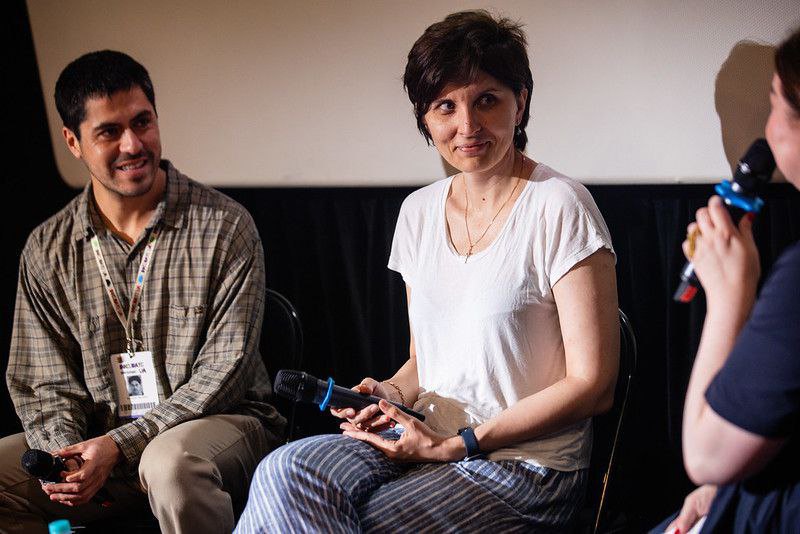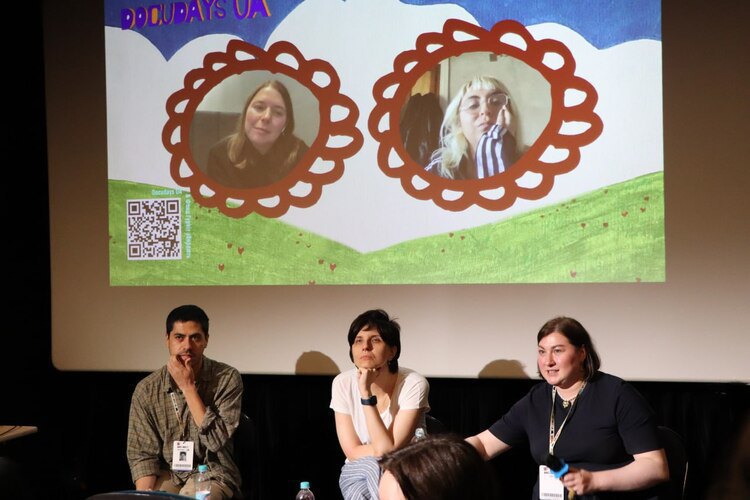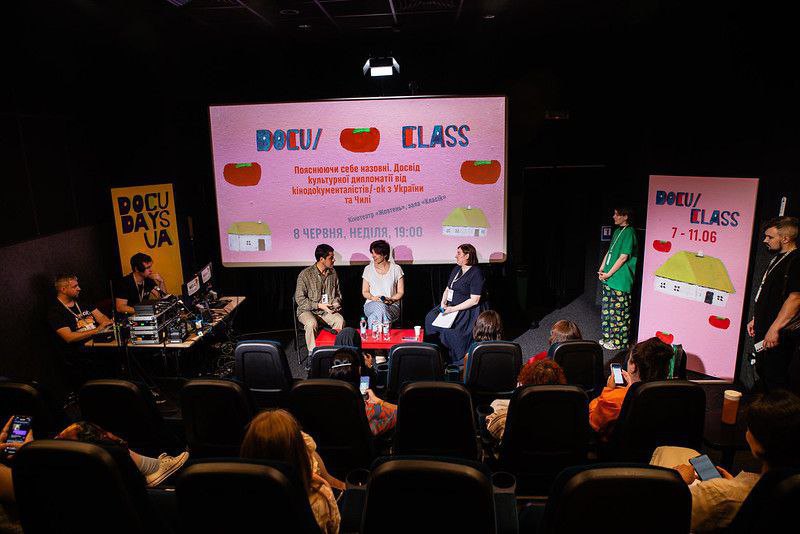Vika Leshchenko, a long-time member of the Docudays team, shared her efforts to promote Ukrainian documentary films internationally in the absence of dedicated institutional support. At that time, screenings of Ukrainian films abroad were rare, and Ukrainian documentarians gathered experience from international festivals to adapt and expand their own practice. Gradually, this process became more organic, driven by growing interest in Ukrainian cinema. There were requests for recommendations of Ukrainian documentaries and filmmakers, prompting the search for tools to spread information more effectively. This led to the publication of a catalogue of Ukrainian documentary films and the formation of Ukrainian delegations to international festivals to enhance visibility. Eventually, specialised institutions such as the Ukrainian Institute and the Ukrainian Cultural Foundation began actively promoting Ukrainian culture on the global stage.

Currently, Vika serves as a programmer for the International Documentary section at DOK Leipzig, where she strives to include Ukrainian films in the programme. Despite the sympathy and support for Ukraine among her colleagues, she notes that many still do not fully understand the context or way of life depicted in these films. This, she believes, underscores the ongoing mission of cultural translation. The greatest challenge, she says, lies in finding a language capable of bridging cultural differences – a task that requires immersion in the environment and greater knowledge of the partner in dialogue.
Nicolás Molina aims to connect with audiences through the language of film and the artistic process – he closely observes how viewers respond empathetically to his directorial choices, especially during international screenings. He also highlights the fragility of translation, particularly when conveying culturally specific elements.

Mariya Ponomaryova emphasises: “Many Ukrainian filmmakers would like to have the privilege of communicating only with images, but in the current situation, most of us are unable to screen our films or participate in events. As filmmakers, we are also cultural diplomats. Wherever we go, we are often asked about the current situation.” She notes the importance of introducing audiences to one’s work through relatable nuances, which helps foster empathy. “When presenting yourself in someone else’s environment, you must also show respect – as if you were a guest in a home with different rules. You need to adjust, study the mentality, and understand who you are speaking to. It is important not to expect others to immediately grasp the pain and struggle being shared. People may wish to, but often they are hesitant – we still live in a post-imperialist world, one shaped by colonial tensions. As a result, there is a tendency to settle for a superficial understanding of our history, interpreting it through a Western lens.”
She adds that because Russian propaganda has been actively disseminated in Western Europe, Ukrainian filmmakers must remain realistic. Attending a screening is not merely an opportunity to present a film – it is also a chance to challenge myths and appeal to audiences capable of critical thought. A crucial aspect of a filmmaker’s cultural diplomacy is to continue creating as an artist, while also testing their perceptions and learning about the local context. Entering a space without such awareness, she warns, can produce the opposite of the intended effect.
Javiera Leal stresses the importance of reciprocity – including in one’s artistic work – and the willingness to listen and learn other people’s stories if one hopes to share stories from their own country. She points out that some Latin American nations are currently experiencing extremist policies, such as cuts to film production funding in Argentina, which undermine the ability of cinema and festivals to act as tools of resistance. Therefore, she argues, it is essential to remain politically aware in one’s actions and their consequences, as this awareness is vital for confronting contemporary challenges.
On cultural context, national experience and the importance of the message
Vika Leshchenko cites the example of one of Docudays’ first major cultural diplomacy initiatives – See Ukraine, headed by Olha Birzul – which introduced foreign audiences to Ukraine through documentary films and was launched at the start of the war. Its primary aim was to reach countries where Russian propaganda was more influential – such as Greece. The absence of significant promotional resources and the presence of resistant audiences posed challenges – yet, from a long-term perspective, it proved to be a rational goal and strategy. While it may seem logical today, reaching countries that are opposed to Ukraine or know little about it – and conveying ideological messages – requires budgets, research, strong motivation and consistency. Cultural diplomacy also demands significant mental resilience, high levels of personal commitment and substantial resources – particularly under the strain of war.
For Nicolás Molina, it is important to convey the Chilean cultural context and his people’s experiences metaphorically, relying on the poetry of images rather than delivering a direct message – the latter, he believes, belongs more to other platforms than to cinema. “I really like this metaphor of emotions as a universal language – understandable without translation,” says Nicolás.
Javiera Leal, the festival’s programmer, explains that in Chile’s national competition they always seek content relevant to the social sector. Many emerging Chilean filmmakers explore the past in relation to the present – for example, Celeste Rojas Mugica’s Uncertain Shadow, presented at this year’s Docudays – while others, like Nicolás Molina with City of Fire, offer poetic portraits of Chilean life and identity. There are numerous themes and layers to contemporary global events, but Javiera’s team believes that direct commentary is not always necessary – it is more important to seek creative ways to represent reality.
Javiera places particular emphasis on the idea that discussion and interaction with the audience are more valuable than the film itself. For instance, this year’s Santiago festival focused on Palestinian cinema, given that Chile is home to thousands of Palestinians. In the absence of Palestinian filmmakers, screenings were followed by conversations with representatives of local organisations – providing greater context and prompting reflection. “We need to remember that the film does not end with the screenings,” Javiera stresses.
Mariya Ponomaryova addresses the pressing issue of how Ukrainian cinema is represented on international platforms – usually confined to a few slots per festival, resulting in a limited portrayal of the Ukrainian context. This stands in contrast to Western European cinema, which enjoys broader representation. She argues that this perception of limited ‘sufficiency’ – the notion that a small selection is enough to understand an entire cultural context – must be challenged. As an example, she cites the Sheffield Film Festival’s controversial panel titled Are There Too Many Ukrainian Films? – which reflects the flawed logic behind such assumptions. It is essential, she argues, to ensure that the call to support Ukrainian voices – a call that gained momentum following the full-scale invasion – does not become a passing trend, but rather a sustained and meaningful commitment.
On the viewer’s attentiveness to other cultural contexts and conscious engagement
Mariya Ponomaryova shares her experience of living in Ireland and Northern Ireland, drawing parallels between Irish and Ukrainian cultures through the lens of their colonial histories. Referring to Timothy Snyder’s lectures, she highlights how cinema – for example, the film The Kneecapor the television series Girls from Derry – helped her to attune her perception to subtle, non-obvious cultural nuances. As a filmmaker, Mariya is deeply engaged in capturing a range of human experiences – this openness encourages her to avoid stereotypical expectations and embrace diversity.

Vika Leshchenko notes that, historically, Ukrainians – like many nations – have often been self-focused and not particularly attuned to global developments. With the onset of the full-scale invasion, this insularity became more pronounced – heightened by the drama and urgency of wartime survival. In such conditions, it is understandably difficult to foster sustained interest in external issues. Nevertheless, she observes a concurrent need to identify a universal language through which Ukrainians can speak about themselves to the international community – a task that poses a significant challenge. In some Western contexts, Ukrainians have faced criticism for a perceived lack of attention to other global conflicts – including the Palestinian issue – despite clear parallels. However, Vika emphasises that it is difficult to expect deep engagement with other struggles when a nation is itself immersed in an existential war of identities, with its own culture under direct attack. At the same time, Ukrainians living abroad often experience greater openness to international issues – aided by distance and relative safety, they are better positioned to research, empathise and engage.
Particular attention is drawn to the issue of film selection at international festivals. It is noted that even respected programmers – when curating works from countries such as Ukraine, Russia, Chile or Palestine – may lack sufficient contextual awareness. This can result in the selection of films that, while appearing aesthetically sound, may in fact propagate misleading narratives or fail to reflect the complexities of the local situation. Vika stresses the importance of engaging qualified consultants from each region to ensure a more accurate and informed curatorial process.
Nicolás Molina reflects that, for him, cinema is less a tool for dissecting cultural contexts and more a vehicle for emotional resonance that transcends specific conflicts. His focus lies in representing a topic as an ambassador and fostering audience engagement – rather than offering solutions within the film industry. He notes that the search for a universal cinematic language can lead in multiple directions: if a film is overly cryptic, it risks being incomprehensible; if it tries too hard to be accessible, it may lose its artistic depth; and if it is too direct, it may be perceived as propaganda. The task, therefore, is to find an authentic voice – one that expresses a unique rhythm of life – and to strike a delicate balance between universality and originality.
Javiera Leal considers the question of for whom films are made and to what end: are they directed outward, towards the international audience, or inward, to unite a domestic public? She acknowledges that films can indeed help foster understanding of a country or a particular situation – but that is not their sole function. “Cinema is art, and documentaries are cinema,” says Javiera, adding, “if we focus too much on information, we risk losing the sensuality and emotion that are integral to the cinematic experience.”

On the cyclical nature of international attention to the Ukrainian experience and the search for a deep and lasting dialogue with the world
Vika Leshchenko recalls the tremendous wave of solidarity and support for Ukraine at the onset of the full-scale war – particularly in the cultural sphere – which resulted in numerous grants and opportunities to screen Ukrainian films, including in Germany. However, this momentum lasted just over a year before beginning to subside. Today, the Ukrainian issue is increasingly losing prominence on the global agenda, gradually being overshadowed by the Palestinian cause – a trend especially noticeable at high-profile events such as the Cannes Film Festival. This shift may be attributed to the international public’s psychological fatigue from the distant war, Europe’s natural inclination towards peace, and the Palestinian topic’s resonance with certain large diasporas. Yet the war in Ukraine persists, and despite widespread exhaustion and feelings of despair, it remains crucial to act strategically, methodically and with consistency – even if only through small steps. Vika emphasises that Ukraine must now invest in shaping its own narrative and cultural diplomacy, as access to funding makes it possible to influence discourse and events. Long-term, stable financing and systemic work are vital to sustain international attention.
Vika also shares another realisation drawn from her professional experience of watching a great number of films – the vulnerability and fragility of the process of creating and presenting Ukrainian cinema in wartime. It demands constant communication and explanation to global audiences in order to preserve understanding and support. Unlike films that are dazzling yet emotionally restrained, or those that adopt a deliberately chaotic artistic freedom, Ukrainian filmmakers are not in a position to create “just an artistic, crazy film” without taking into account public opinion – as doing so carries tangible risks. “This is, for example, the difference between Ukrainian and Russian films,” Vika explains, “because for those people, there is nothing to lose – and it’s quite the opposite for us, because it’s a matter of survival in how we communicate with the world.” Ukrainians cannot afford excessive emotionality in their artistic statements – especially given global war fatigue and the constant loss of life on the front lines. These are the stark realities Ukrainian cinema must reckon with today. It has become a vital instrument of cultural diplomacy – and that inevitably shapes its form and purpose.
Mariya Ponomaryova also notes that consistency is indeed very important in solving the problem, and despite the volatility of the world’s reaction, Ukraine needs to remind itself of itself so that people learn more about us and recognise us. Despite possible calls from film critics to surprise the viewer, Mariya believes that Ukrainian films should be about something that truly holds dramatic meaning for us – something we care about and connect with deeply. The most important aspect of this, she argues, is preserving the diversity of voices within Ukrainian cinema. Ukraine is fortunate to have a range of strong voices – each with distinct focuses, interests and areas of emotional resonance.
Mariya further stresses the importance of mutual support over competition – even in a highly competitive market environment. Filmmakers should celebrate one another’s work, attend each other’s premieres at international festivals, and recognise each other’s achievements – fostering a sense of unity. She also underlines the necessity of solidarity: “Because from Ukraine to Palestine, occupation is an evil act. It is important to emphasise this, not to compete – because shifting the focus of Western Europeans is their responsibility, not something we should complain about.” Ukraine has many powerful civic initiatives and, despite certain difficulties in dealing with governmental bodies, institutions like the Ukrainian Institute play an essential role in promoting Ukraine properly within the international cultural sphere, even in the face of declining external support.
“We are more than just a trend, someone’s sensation or a country exceeding other people’s expectations. And yes, sometimes we do have to create ‘polished’ films in order to be more easily understood by international film audiences. But we have a wonderful expression in Ukraine that reflects our stance: ‘We have to do our own thing.’ And we have our responsibilities. Like our colleagues in Chile, we have to be active citizens. Beyond our cultural obligations, we must also connect people to our lived realities when we present our culture abroad. We must follow our own path – not waste our energy on internal quarrels, but instead support one another and make space for difference. Because if we are good partners, we will not be victims – even in survival mode,” says Mariya.
“We do not need to be pitied – but our pain must be acknowledged. Here in Ukraine, we feel how hard it is to sustain the international audience’s attention, especially when it comes to the war. That is why we must remain extremely flexible – transforming our messages and narratives to keep those points of attention. Because, ultimately, this is not a sprint – this is a marathon.”








